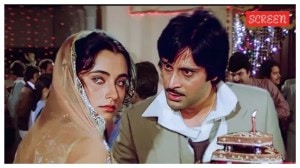9 cows in custody, Bhiwandi on edge
It's never taken much to spark a communal riot in the depressed power-loom town of Bhiwandi in Thane district. But detaining nine cows? Last...

It’s never taken much to spark a communal riot in the depressed power-loom town of Bhiwandi in Thane district. But detaining nine cows?
Last night, the police took the animals into custody.
With just two days to Bakri Eid, Bhiwandi erupted in violent clashes between the police and Muslims. At least 34 were injured, including 26 policemen, and many vehicles were smashed.
The town was swathed in tension today as elite anti-riot Rapid Action Force units were deployed. You can still see the blood stains on the watch of Deputy Commissioner of Police (Zone II), D M Phadtare.
‘‘We are finding out why this took place; our first job is to restore peace,’’ Minister of State for Home Rajendra Darda told The Indian Express. ‘‘The commissioner and joint commissioner are camping in Bhiwandi to keep a watch on the situation. Peace committee meetings have been convened.’’
Darda said illegal transport of cattle could have been an issue, but investigations are underway.
As always with religious violence in these polarised times, it wasn’t an open-and-shut case. The communal cauldron in Bhiwandi had been first stirred by the extremist Bajrang Dal. Add to that some incitment by Muslim leaders and the stage was set for yet another clash in the town’s long history of violence.
It began when the police of the Nadi Naka outpost in Nizampura took cognizance of a verbal complaint of Bajrang Dal activists, who said they ‘‘suspected’’ that cattle from the market were being taken for illegal slaughtering for Id Ul Zuha.
Night had fallen when the police took custody of the nine cattle that were brought to the market to be sold. Rumours spread, some incitement followed and soon a 1,000-plus mob gathered outside the police outpost demanding the immediate release of the cattle.
The tension built up as the stand-off between the mob and police continued. As the mob grew restive, some of them began hurling stones and bottles at the police, who had called in reinforcements by then. The stones and bottles soon came thick and fast.
Beleagured, the police fired tear-gas shells. When firing in the air and tear gas failed to disperse the mob, officials ordered a lathicharge. None of this is new to Bhiwandi. Riots are old hat in a town littered with shuttered power looms and plagued by high illiteracy. But police sources said that Bajrang Dal activists have been particularly active with two similar incidents diffused on the night of January 30 and February 1 in neighbouring Kalwa.
‘‘Though illegal slaughtering takes place round the year, the alarming fact is that Bajrang Dal activists take up the matter only during Bakri-Eid when every Muslim would be looking forward to make qurbani (sacrifice),’’ said community leader Abdus Salam Azmi.
‘‘I feel they do this with mischievous intent to create problem between the police and the community.’’ Azmi, who has witnessed vicious communal riots in his town during 1970 and 1984, says this is a recent problem.
‘‘After the Babri Masjid was demolished the world paid visit to Bhiwandi to see how this textile township maintained peace,’’ said Azmi. ‘‘However after Gujarat incidents, communal forces have been on the rise, though in a small number.’’
Last year, when the local police did not entertain the complaints of Bajrang Dal activists before Bakri-Eid, the saffron brigade filed 40 individual cases in the magistrate’s court, alleging incidents in which cattle were to be illegally slaughtered.
Their lawyer, Lalit Jain, who had pursued all the 40 cases was later shot dead. Even then Bhiwandi did not erupt; there were only some sporadic incidents of violence.
‘‘After the Gujarat incidents, the textile business in Bhiwandi gained momentum and the cosmopolitan population, which is in some way or the other dependent on the textile business, savored the fruits of the boom,’’ said Kalamuddin Khan. ‘‘The people do not want trouble — trouble means losses.’’
Photos



- 01
- 02
- 03
- 04
- 05




























